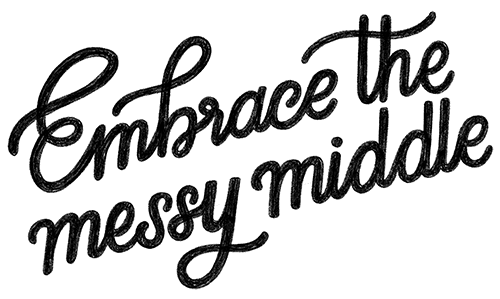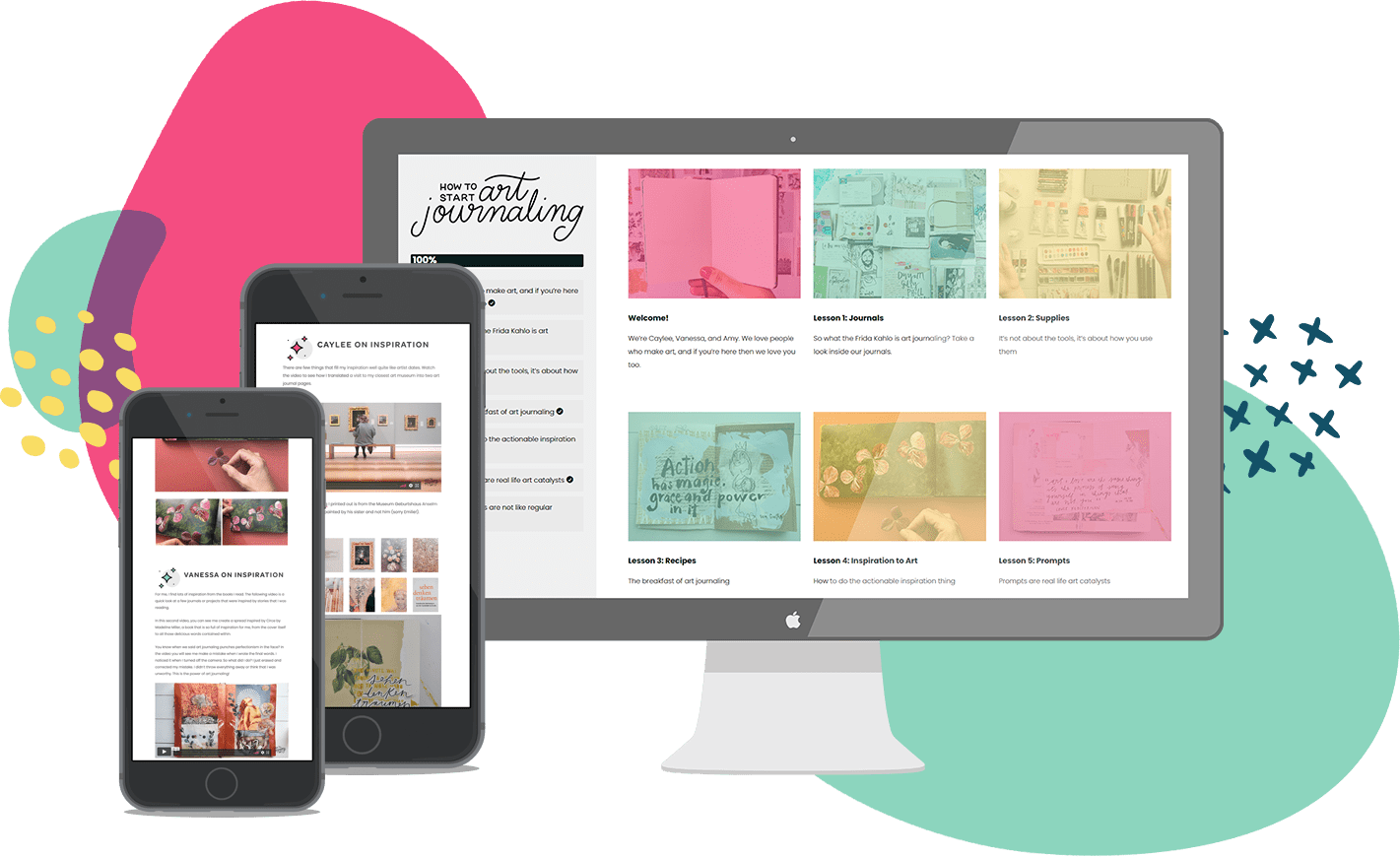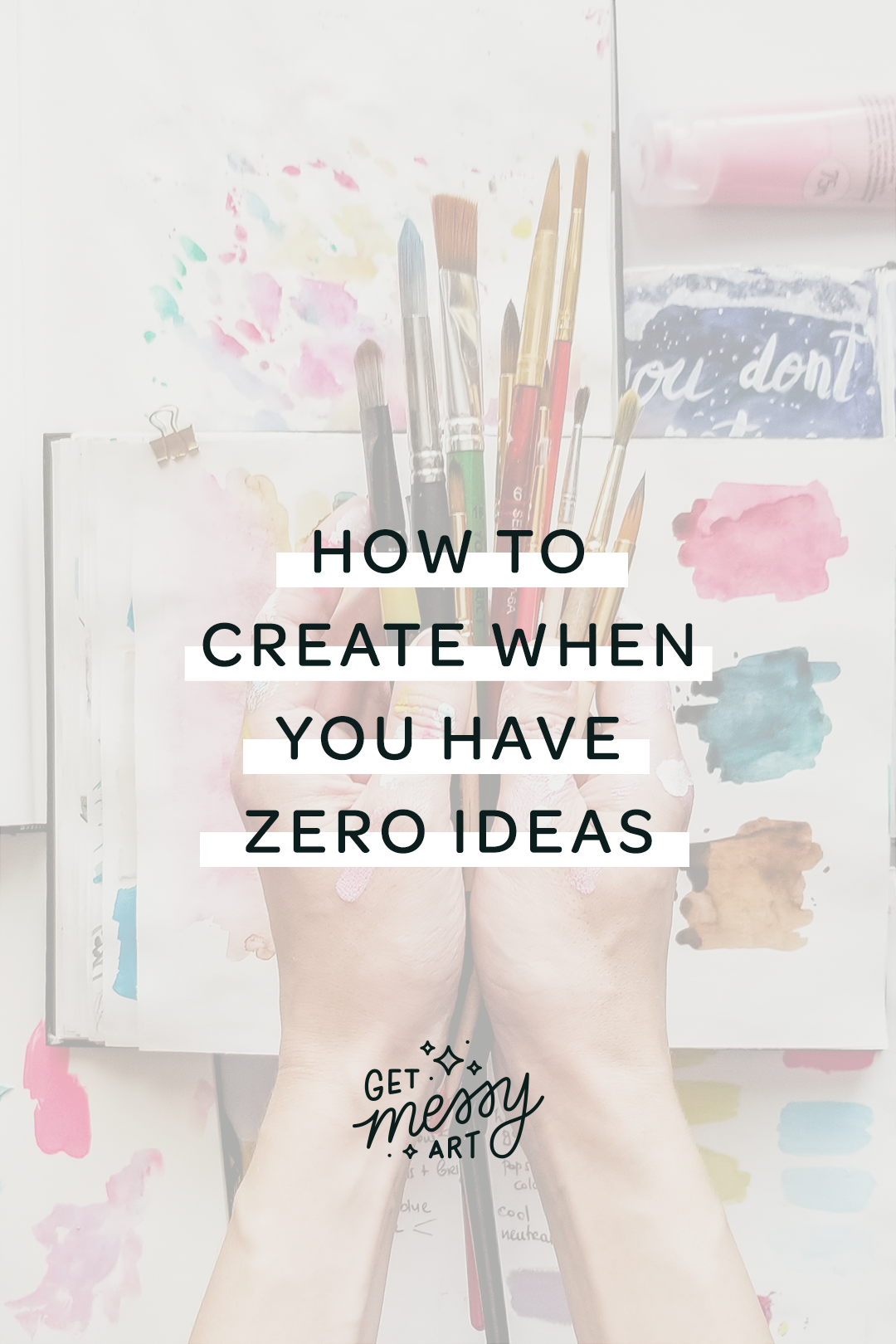Want to make art but have no clue how to get started? Perhaps you know these symptoms all too well: You have the aching feeling inside of you that comes from not making, but it’s accompanied that pesky voice that tells you that there’s no point. You have zero ideas anyway, says the voice. You’re not cut out for this.
First, please tell that pesky voice from me that it’s talking bullshit. You are cut out for this. Second, rest assured that your current quantity of ideas does not equate to your worth as an artist or a human. And third, know that what you’re experiencing – although painful – is fine and normal.
Many a creative is plagued by the same predicament. Our internal creative landscapes can feel much more like deserts than thriving oases. Why is it that the only things thriving here are sand and tumbleweeds?!
The truth is, sometimes inspiration simply dries up. At the moment, it doesn’t matter how or why you’ve landed here – and as I mention later on, dwelling on it can make things worse. What matters for now is that you start making again: so here are fifteen tips for how to create when you have zero ideas.
1. Sign up for a class
Whether in person or online, classes are great because they’re led by someone who is not you. You can officially relax into the role of the learner. It’s not your task to come up with new ideas or to steer the direction of the art making…all you have to do is show up, and take your cues from the teacher/tutor/facilitator. You’ll discover new materials, techniques – and hopefully even some new ideas – along the way.
2. Look at your old artworks
Take inspiration from yourself by looking through your old artworks. Above all else, this is living proof that you can create, and that (at least sometimes) you have ideas. Are there any recurring themes or materials that you notice? Do you like what you see? Which parts repulse you, and which parts delight you? Whatever your answers to these questions, you can use your old work as either as a foundation to build new work upon, or a point of departure from which to leap in an entirely different direction.
3. Paint over your old artworks
When I said “use your old work as a foundation to build new work upon” I was speaking metaphorically. But if those old artworks aren’t serving any purpose anymore – and especially if you hate what you see – go right ahead and paint over them. Pick a colour, any colour, and block that shit out. Destroying a painting to make a new one is the ultimate bad-ass move of creative liberation. It doesn’t just remove an unloved artwork from precious storage space or create a physical foundation for a new painting: it also creates mental space, a fresh start.
4. Join a 30 day challenge
30 day challenges (as with five day challenges, year-long challenges, any-length challenges) serve a similar purpose to signing up to a class: it takes away the initial decision-making pressure and sets a structure for your art making. Within that structure, you have room to play. Even if you resent the room to play because you really really really have zero ideas and you end up taking thirty black and white photos of your cat over the course of the challenge…well, that’s thirty black and white photos of your cat in the world that wouldn’t have otherwise existed. And you know that you probably like making art involving your cat. I call that a creative win.
You can find a great bunch of 30 day challenges with our friends over at Creative Bug and Kick in the Creatives.
5. Set your own challenge or structure
Don’t find a 30 day challenge that you’re into? Set your own. Choose a theme, pick a medium, define a length of time. As I’ve talked about previously, setting ourselves a structure is a wonderful way of getting out of a creative funk.
6. Grab a buddy
In a Get Messy Podcast episode, Get Messy Fairy Artmother Caylee talks about having a friend accompany you on your creative journey being like getting the mushroom in Super Mario. It’s totally also like getting the star (cue awesome sped-up motivational music while you zoom around the track). Ask one of your creative friends if they’ll be your creative accountability buddy. Talk about your creative highs and lows. Whether IRL or over zoom, sit together with a bunch of art supplies and start making.
7. Choose an artwork you love and try to recreate it
Having dealt with the huge issues of authenticity, fakes and forgeries in an international auction house, I’m definitely not suggesting that you recreate a work and then attempt to pass it off as the real deal. Having said this, the popular art school exercise of “copying the old masters” is great for several reasons: firstly, it gets you to focus on technique. Secondly, it takes all of the pressure off having to be original and come up with any ideas of your own. And, ultimately – unless you’re Pei-Shen Qian or Beltracchi – it will prove that, even when copying, you are original and do things in your own way.
8. Complete your unfinished projects
Go on, admit it: you’ve got a stash of unfinished projects lying in a forgotten box / drawer / cupboard / corner. We all do. Get ’em out. Get cracking. If you really can’t bear looking at these stagnant projects, paint over them, disassemble them, get rid of them or turn them into something else. Don’t let them guilt you into keeping them with that whiney old “but one day you might…”. Whichever way you go, you’ll feel much better for it.
9. Follow a Messy Recipe or respond to an art prompt
A Messy Recipe is a set of simple, step-by-step instructions for making art when you want to be making but have zero ideas – and art prompts are much the same. You can find countless art prompts and Messy Recipes inside the Get Messy members’ area. To get you started, here are two prompts from the free Get Messy class, How to Start Art Journalling:
Prompt 1
Respond to this quote by Chuck Klosterman: “Art and love are the same thing: It’s the process of seeing yourself in things that are not you.”
Prompt 2
Create a self-portrait using items that represent you.
Sign up to the free class for more inspiration and information about the magic of prompts.
10. Go abstract
By working with abstraction, we allow ourselves to forget about concept and to instead focus on colour, shape, line, size and form. Of course, this is not to say that abstract art has no concept or that all figurative art does – but it takes some of the pressure off. So make some marks. Draw hundreds of little triangles. Play with different colour combinations. Delight in the patterns (or lack thereof).
11. Use the materials that you made art with when you were a kid
Often we’re so caught up in being serious artists that we forget to enjoy our art making along the way. Working with the materials of our youth brings back awesome memories and gives us permission to have fun. I’m giving you the permission now, in any case.
Think Spirograph, paper marbling, pasta necklaces, tie-dye, homemade playdough, scrunched-up coloured tissue papers, papier-mâché, the magic of watercolour-over-white-crayon. Heck, while you’re at it, you can even grow a chia pet if you get the urge. Bonus if the materials belong to your children. Double bonus if the materials have been hanging around since you were a kid.
12. Go through your saved Instagram images or Pinterest boards and actually make one of the projects
These are often the projects we’ve saved for “when we finally have the time”, but we somehow completely forget about them when we’re in a creative drought. So call on this resource when you have zero ideas. So scroll away and pick a project – then gather what you need and get making.
13. Draw that which is around you
Don’t know what to draw? Start with your home environment. Draw your bedroom, your dog, your partner, your kids, your kitchen utensils, that weird vase in the back of the cupboard, your book collection, the view from your window. Think you can’t draw? It doesn’t matter. Document every inch of your living space fervently, with black marker. Then do it again, this time in colour.
14. Try a new medium
Sometimes, we’re simply stuck in our old ways. Trying a new medium gets us into beginner’s mind and often opens up creative doors (read: ideas) that we didn’t even know existed. Be aware that you will (probably) not be great straight away – but take comfort in the fact that you’re allowed to suck. Make a mess. Practise. You’ll get better.
15. Collage
I’m a huge fan of collage. Part of its beauty is that, in working with pre-existing images, we’re working with pre-existing seeds of inspiration. Grab an old magazine and cut out a bunch of images which speak to you or grab your eye. Move them around, place them next to and on top of each other. You don’t even need to glue anything down: amidst the mish-mash, new images and ideas will begin to appear, almost of their own accord. Suddenly a girl who was walking home from school is now walking in the clouds; a previously-carnivorous dinosaur is practising its new-found veganism by eating a flower.
Simply begin.
Having zero ideas is a tough place to be – mostly because, when we focus too much on the fact that we have no ideas, we get stuck feeling terrible about ourselves. And you know what happens when we feel terrible about ourselves…if there were any potential ideas which were hanging anywhere nearby, they get scared, run around in circles for a few seconds and then run for cover.
The way to combat this is to go easy on yourself. Accept that you’re in a rough creative patch with little-to-no-ideas, and start making regardless. Ultimately, it doesn’t matter what you’re making – it simply matters that you’re making. So simply begin. Through your slow and steady making, your ideas will eventually feel safe enough to come out of their hiding place and grace you with their presence once more.



